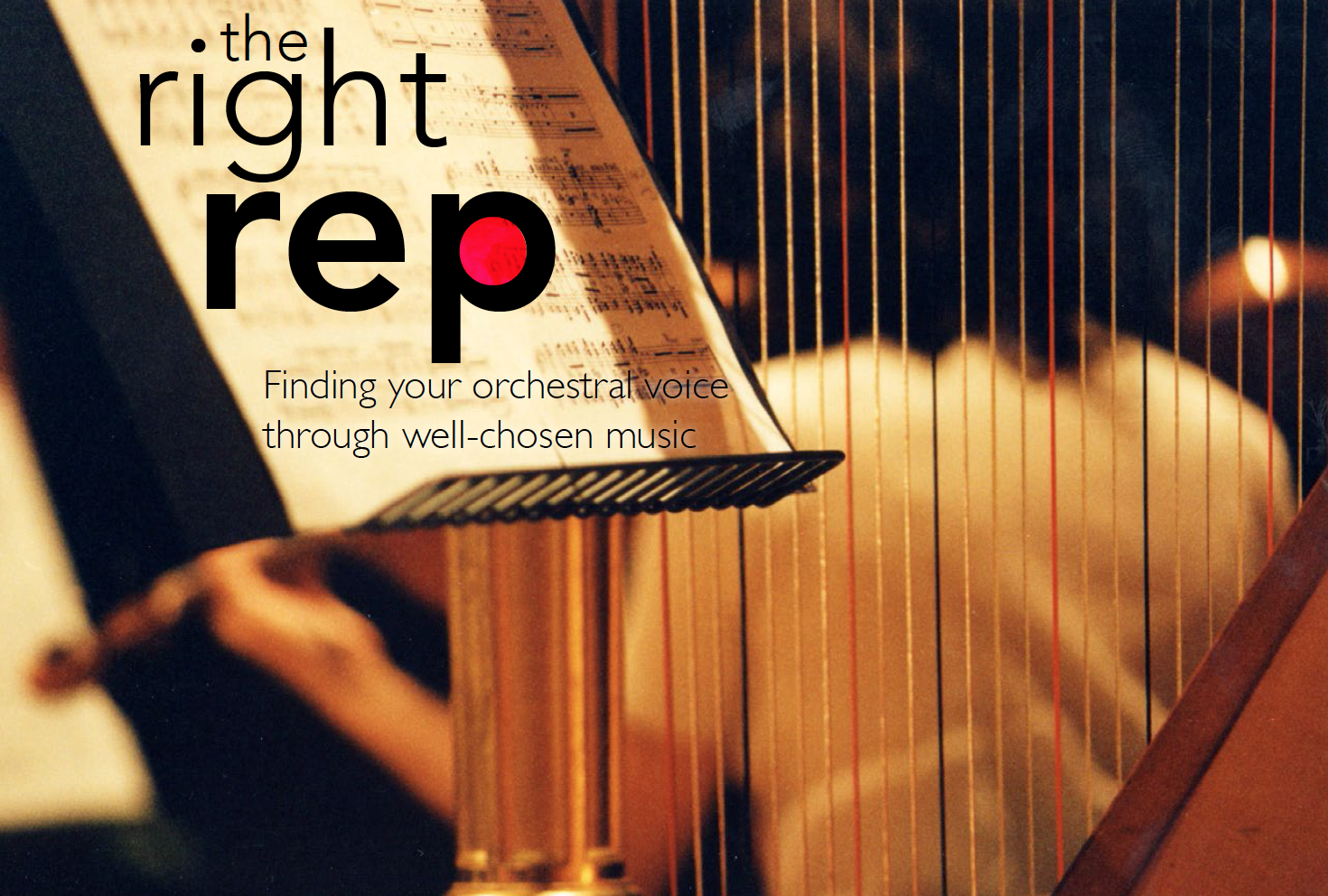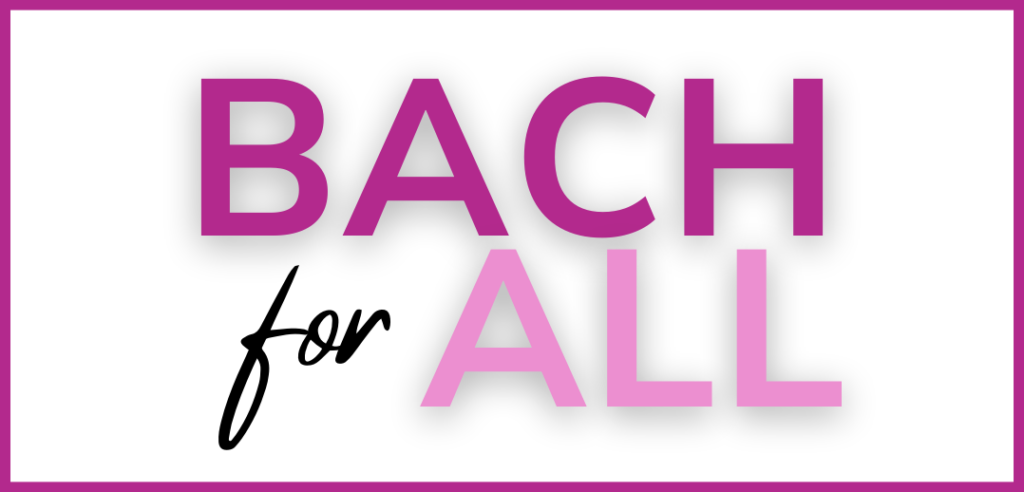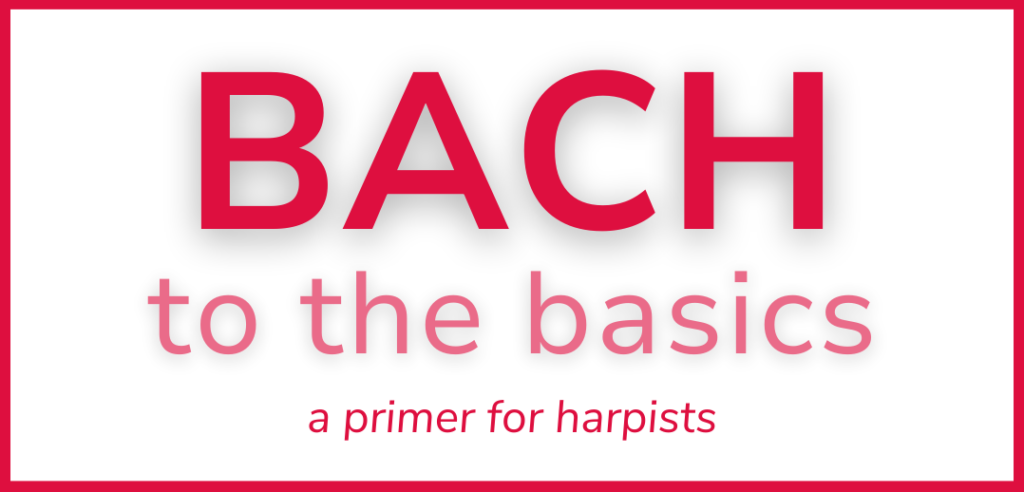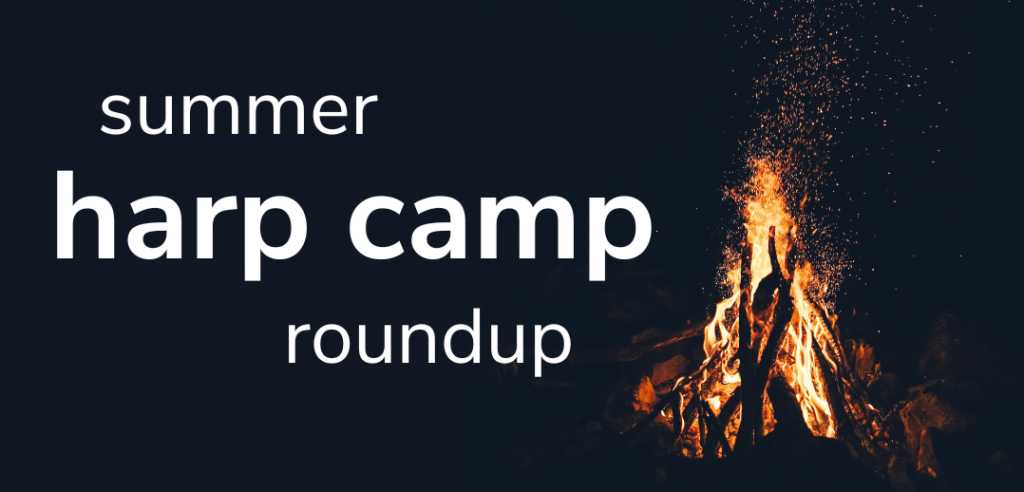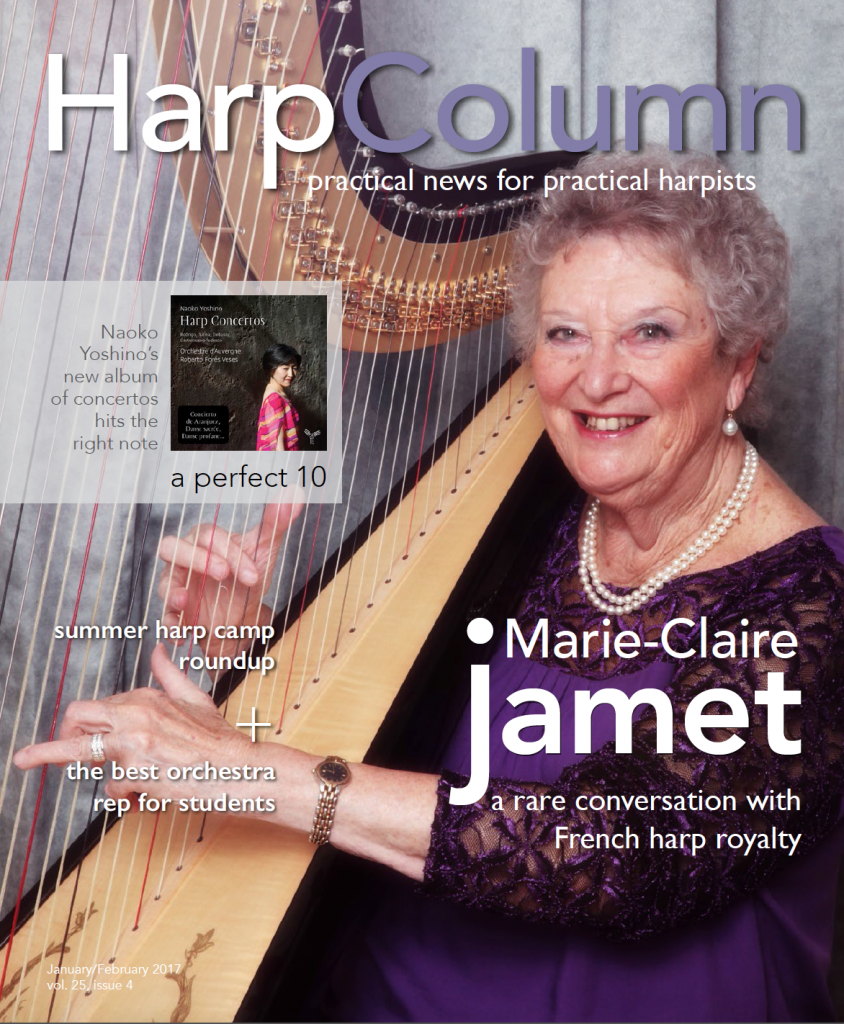—by Michelle Gott
Article Extra
Get the author’s tips on how to prepare for the first rehearsal in Preparing for the Downbeat.
For young harpists, the journey from finding middle C to succeeding in the symphony can seem like a long and dauntingly steep climb. Orchestral performance requires harpists to conquer technical skills of course, but also, because of the soloistic nature of much of the repertoire, requires harpists to independently follow a conductor, listen and respond to other instruments, and develop steadfast and confident rhythm. But with some diligent preparation and well-chosen repertoire, the journey to orchestral harpist can be a fun and rewarding one.
Harp teachers naturally hope for their students to receive as much time in orchestra as possible. Conductors, however, must consider the needs and skills of the collective ensemble, offering challenges and rewarding opportunities across the orchestra. Fortunately, there’s a large body of orchestral repertoire that includes harp and also provides excellent ensemble training. For conductors hoping to feature their student harpist, there are also solos that work very well with orchestra or band. A survey of this repertoire will hopefully inspire conductors, teachers, and student harpists to feel empowered by their programming!
Intro to orchestra: Easy repertoire
• Trad, arr. Kathy L. Fishburn: Celtic Fiddles: A Medley of Traditional Scottish Fiddle Tunes
This entertaining piece for string orchestra features an optional harp part with easy three-note chords played staccato to match the string pizzicati.
• Copland, Aaron: Rodeo Suite
Excerpted from the ballet, Rodeo, three of the movements (“Corral Nocturne,” “Buckaroo Holiday,” and “Saturday Night Waltz”) feature a simple but important harp part. In “Buckaroo Holiday,” an exposed passage highlights celesta and harp in ostinato material. Rodeo is a great introduction to Copland’s style, particularly to the experience of significant metric shifts.
• Edlund, Ian: Butterfly Ballet
Written for string orchestra plus harp, this charming piece contains no pedal changes in the harp part. Arpeggio and octave patterns are split between the two hands, leaving the student free to focus on the conductor
• Smetana, Bedrich, arr. Robert S. Frost: Themes from “The Moldau”
This arrangement contains an optional piano part doubling the string parts that can be readily adapted for harp. It may require some simplification of octave doubling and chord spacing.
• Strauss, Johann: Overture to The Gypsy Baron; Blue Danube Waltz
Both selections by Johann Strauss offer excellent solo opportunities for the wind players and give the developing harpist an appropriate first orchestral experience. In The Gypsy Baron, there is a very short passage of chordal accompaniment, while The Blue Danube features a simple arpeggiated section that fits comfortably in the right hand and includes minimal pedal changes.
• Stravinsky, Igor; arr. Merle J. Isaac: Firebird Suite: Berceuse and Finale
Suitable for a less advanced orchestra, this arrangement is a wonderful introduction to Stravinsky for young harpists.
• Ungar, Jay; arr. Bob Cerulli: Ashokan Farewell
Bob Cerulli’s orchestral arrangement of this gorgeous theme from the PBS mini-series, The Civil War, includes an optional piano part that can be readily played on the harp. Requiring only a few pedal changes, the part would be suitable for any student comfortable with three-note chords in the right hand and a simple left-hand accompaniment.
• Walton, William: Richard III: A Shakespeare Suite
Harp is included in two of the six movements from this film suite, including a lovely, simple duet for flute and harp in movement three, “The Princess in the Tower.” The harp accompanies the flute with a simple triplet figure, followed by light harmonics.
• Williams, John; arr. Carson Rothrock: Theme from “Superman”
The challenge of this harp part lies with the multiple grace notes that must come before the beat, in combination with some pedal changes and left hand ostinato.

No longer a newbie: Lower Intermediate
• Bizet, Georges: Carmen Suite No. 1
This well-known operatic suite features rhythmic, repetitive patterns in the Aragonaise, challenging the student to play with precision and dynamic control. The famous Intermezzo provides a wonderful highlight for the flute and harp.
• Bruch, Max: Kol Nidrei, Op. 47
This expressive work, written for solo cello and orchestra, features a simply beautiful accompaniment of rising harp arpeggios that fit easily into three-note patterns for each hand.
• Chausson, Ernest: Poème, Op. 25
In this beautiful work featuring solo violin, the harp part is minimal but important. The arpeggios at rehearsal 18 mostly fit into patterns of three notes per hand but some harmonic notes can be removed to simplify the fingering if needed.
• Dvořák, Antonín: Carnival Overture
Although the tempo is quick, the exposed arpeggios and chords fall easily into the hands. The conductor may wish to focus on the transition into rehearsal L, which involves a rhythmic change in the harp part to off-beats through a ritardando.
• Elgar, Edward: The Wand of Youth, Suite No. 2
The harp is included in two of the six movements. In the first movement, “March,” the chords at rehearsal numbers 6 and 10 are exposed but played within a stately tempo. The harpist will need to be rhythmically solid for the triplet/dotted-eight note figures of the first movement and the off-beat chords in the third movement.
• Elgar, Edward: Pomp and Circumstance, No. 4, Op. 39
Featuring only chords and two glissandos, this harp part is a challenge for steady march rhythm and stamina but contains minimal pedal changes. The part can also be doubled by a second harpist, in which case the directions should be followed to play an octave higher where indicated.
• Elgar, Edward: Sospiri, Op. 70
This beautiful adagio for string orchestra and harp (and organ, ad libitum) features slow, rolled chords and requires the harpist to play with great expression and rubato.
• Kabalevsky, Dmitry: Overture to Colas Breugnon
This simple harp part is a good introduction to playing in cut time and to rhythmic glissandos while offering a rewarding experience for the full orchestra and the audience.
• Mussorgsky, Modest: Night on Bald Mountain
The harp part is minimal, entering only near the end of the work, but features exposed eight-note, ascending arpeggios in D Major. For less advanced orchestras, there is also an arrangement by Carl Simpson (Ludwig Masters Publications), to which the original harp part could be added.
• Offenbach, Jacques; arr. J.G. Busch: Overture to Orpheus in the Underworld
Featuring exposed chords in a relaxed tempo, this overture is a great introduction to accompanying solos around the orchestra, beginning with the cello and later on the flute and violin. Some pedal changes are required in the Allegretto but can be simplified by using B-flats for the written A-sharps and G-naturals for the F-double-sharps.
• Saint-Saëns, Camille: Danse bacchanale
This excerpt from the opera Samson et Dalila highlights the wind section, including an excellent opening solo for oboe. The harp chords at rehearsal 225 are exposed but within a very reasonable tempo, enabling the harpist to keep a firm eye on the conductor. Special attention may need to be given to the tempo change at rehearsal 245, where the harpist plays two sequences of descending, exposed chords.
• Shostakovich, Dmitri: Cheryomushki: No. 1, “A Spin Through Moscow”
From the satirical operetta by Shostakovich, this excerpt does not have a harp part but one can easily be adapted from the chord structure. Although unpublished, Angus Armstrong from the Ottawa Junior Youth Orchestra created a harp part in this way. To obtain his arrangement, email angusarmstrong@sympatico.ca.
• Smetana, Bedrich: Ma Vlast: No. 2 Vltava (“The Moldau”)
This beautiful tone poem highlights a skilled wind section, particularly the flutes and clarinets in the opening passage depicting the two sources of the Vltava River. The harp part features exposed single notes accompanying the winds followed by a simple chordal passage. Later on, in the “Dance of the Nymphs,” the harpist plays exposed chords and arpeggios in a relaxed tempo, accompanying the strings and winds.
• Tchaikovsky, Pyotr Ilyich, arr. Jerry Brubaker: Romeo and Juliet Overture
This is an abridged version of the overture to Romeo and Juliet, suitable for a less advanced orchestra. The harp part is very close to the original with one difference of key in the opening, rising chords. For the concluding passage of chords, Brubaker has written the harp part in B major and simplified the original chords. The original part is written in the enharmonic key of C-flat major, which is better for intonation. It may be advisable to either play the original part in this concluding passage, or transpose the simplified chords into C-flat major. If the student learns the simplified chords in C-flat major, that will also lay the groundwork for learning the full part later on.
• Wagner, Richard: Overture to Die Meistersinger
Doubling the brass, the harp part features short chordal passages with minimal pedal changes. The challenge is to play the chords (quickly rolled or slightly cracked) with rhythmic precision and shaping.
• Williams, John; arr. Jerry Brubaker: Harry Potter Symphonic Suite
This harp part will challenge the student’s rhythm and ability to shift meters but contains simple figures that can be easily divided between two hands.
Next steps: Upper Intermediate
• Arnold, Malcolm: Four Cornish Dances, Op. 91
This lively work provides great rhythmic training for the upper intermediate harpist. There are some exposed but slow arpeggios in the second movement accompanying wind solos. This part is best suited for a student comfortable with pedal changes and larger chord spacings (as required in the third movement).
• Bernstein, Leonard: Overture to Candide
This overture provides excellent solo opportunities for the winds and brass and challenges the harpist to play with rhythmic precision.
• Borodin, Alexander: Polovetzian Dances
This harp part mostly contains simple chords or single notes, with the exception of the final passage wherein the harpist must jump quickly between the high and middle registers. The material could be simplified, however, by removing some notes from the chords, enabling the harpist to keep the right hand in the upper register.
• Burge, John: The Canadian Shield
Written in 2001 by Canadian composer John Burge, this expansive and descriptive work includes an optional harp part. Beginning in measure 120, if the right-hand arpeggio material is too difficult for the student, try simplifying by removing the left hand eighth notes and splitting the right hand between the two hands. The slow tempo (approx. quarter note = 60), however, makes this slightly awkward passage more doable given enough practice. Advise the student to bring up her dynamics at measure 135 as this material tends to get lost in the texture.
• Elgar, Edward: In the South, Op. 50
Although published with two separate harp parts, most of the material is doubled and could be played with one harpist. Arpeggios and chords fit easily into the hands, and the double glissandi can be modified to one line if the student is having trouble reaching the top with both hands.
• Franck, César: Symphony in D Minor
The second movement begins with very exposed chords in the harp, requiring sophisticated muffling, clean placing, and precise pedal changes.
• Kalinnikov, Vasily: Symphony No. 1
The harp is featured in three of the four movements. In the first movement, right-hand arpeggio material fits easily into four-finger patterns. The exposed oscillating thirds in the second movement provide a good challenge in stamina and steady rhythm. Pedals will have to be carefully marked for the passages containing multiple double-sharps at rehearsals B and K.
• Khachaturian, Aram: Sabre Dance
This well-known crowd-pleaser highlights the percussion and brass sections. The harp part is a stamina challenge of fast, loud off-beats, plus a very exposed pentatonic scale at the conclusion with octaves in the left hand.
• Liszt, Franz: Symphonic Poem No. 3: Les Préludes
The opening arpeggios for the harp fit easily into four-note patterns for each hand. Material from measures 280-312 requires good coordination between the two hands and a solid fingering for the right hand.
• Massenet, Jules: Le Cid Ballet
While not technically challenging, this harp part provides an excellent experience in accompanying, most notably in the “Aubade” and “Madrilène.”
• Rival, Robert: Maya the Bee
Commissioned by the Ottawa Youth Orchestra in 2006, this entertaining work for orchestra and narrator by Canadian composer Robert Rival includes an upper intermediate/advanced harp part with exposed descending triplets for the right hand and low octaves.
• Rival, Robert: The Great Northern Diver
Another commission by the Ottawa Youth Orchestra, this four-movement work evokes four scenes of the common loon (the “great northern diver”) on a starlit lake, diving, wailing, and finally taking flight. The harp part features exposed octaves requiring some challenging pedaling and attention to clean playing especially in the bass register, but the slow tempos make this very doable.
• Rodgers, Richard and Oscar Hammerstein; arr. Robert Russell Brown: The Sound of Music, Selections for Orchestra
In this arrangement from the popular musical, the harpist plays mostly chords that can be simplified from four to three notes if needed. Pedal changes are frequent and more suitable for an upper intermediate/advanced player.
• Saint-Saëns, Camille: Marche Héroïque
The material at rehearsal E requires solid fingering and the ability to slide octaves, but the remaining arpeggio and broken octave material fits easily in the hands.
• Tchaikovsky, Piotr Ilyich: Capriccio Italien
This harp part features rhythmic octave and chordal figures as well as exposed arpeggios. The student should be comfortable playing quick arpeggios including hand-crossing. For less advanced orchestras, there is also an arrangement by Merle J. Isaac to which the original harp part can be added.
• Tchaikovsky, Piotr Ilyich: Romeo and Juliet Fantasy-Overture and Francesca da Rimini
Both works are similar in difficulty for the harpist. In Romeo and Juliet, the main challenge is in the chordal passage at rehearsal J, which requires very clean placing between chords, a light and clear tone, precise pedaling, and steady rhythm. The arpeggios in Francesca da Rimini flow readily given a solid fingering.
• Villa-Lobos, Heitor; arr. John Krance: Aria from Bachianas Brasileira No. 5
In this arrangement for orchestra, the harp part is optional but provides excellent training for lyrical playing in mixed meters. The numerous tempo changes and expressive rubato will require the student to develop great flexibility in following the conductor, particularly from rehearsals 40-50.
• Walton, William: Crown Imperial Coronation March
First performed at the coronation of King George VI in 1937, this orchestral march was more recently included as part of the Royal Wedding between Prince William and Catherine Middleton in 2011. The harp part features grand chords and sweeping glissandi, challenging the harpist to play with stately rhythm and broad dynamics.
• Williams, John; arr. James H. Burden: Star Wars Medley
Although the material in the harp part fits easily into the hands, the challenge is following the quick tempos and multiple metric shifts.
Orchestra veteran: Advanced repertoire
• Bizet, Georges: L’Arlésienne Suite No. 2
This harp part contains advanced scalar and arpeggio material as well as an excellent duet for the flute and harp in the “Menuet.”
• Bruch, Max: Scottish Fantasy
This exciting work for solo violin is very challenging for the harpist, requiring clean chords, stamina, and both rhythmic and lyrical accompaniment.
• Chabrier, Emmanuel: España
Featuring two harp parts, this is a very challenging, rhythmic work requiring precise playing from both harpists. Advanced arpeggios, bisbigliando, and staccato are the main skill requirements.
• Holst, Gustav: The Planets
Requiring two harps, the difficulty ranges from advanced to very advanced. There are many exposed sections, such as the harmonics in “Saturn,” chords in “Venus” and “Uranus,” and major arpeggio, bisbigliando, and trill requirements in “Jupiter” and “Neptune.”
• Khachaturian, Aram: Adagio from Spartacus Ballet Suite No. 2
This beautiful excerpt features a challenging harp part with extensive pedal changes.
• Prokofieff, Sergei: Romeo and Juliet, Suites 1 and 2
These suites are very challenging for the orchestra in general. For the harpist, pedaling changes are extensive, and solid fingering must be worked out for several tricky arpeggio passages (e.g. Suite 1, Mvt. 6, reh. 54-57; Suite 2, Mvt. 5, reh. 46-49).
• Rimsky-Korsakov, Nicolai: Capriccio Espagnol
This exciting work highlights solos around the orchestra, including a harp cadenza filled with flair! The “Fandango Asturiano” has some challenging rhythmic passages in unison with the flute and piccolo, requiring solid fingering and steady control.
• Tchaikovsky, Pyotr Ilyich: Ballet Suites: Swan Lake, The Nutcracker, Sleeping Beauty
All three suites have challenging harp parts with featured cadenzas. The harpist must be comfortable playing extended, cross-handed arpeggios and large, rolled chords. John Gomez, conductor of the Ottawa Youth Orchestra, highly recommends ballet repertoire as the dance rhythms and character dances offer consummate training in musicianship.
• Vaughan-Williams, Ralph: Five Variants of “Dives and Lazarus”
This gorgeous work for string orchestra and harp requires creative fingering, especially for “Variant III,” and clean placing.
• Verdi, Giuseppe: Overture to La Forza del Destino
Although written with two harp parts, it is possible to play only the first part. The student must be comfortable playing repeated triplet arpeggio figures in the right hand and jumping octaves in the upper register. It is possible to simplify some of the arpeggio material by removing some notes from the doubled bass octaves and using the left hand to assist with the right.
• Williams, John: Star Wars: Suite for Orchestra
This full suite features a challenging harp part with multiple arpeggios, metric shifts, exposed solos, and extensive pedal changes.
Solos with orchestra
If given a solo opportunity, an advanced harp student would do well to experience Debussy’s Danses sacrée et profane or Handel’s Concerto in B-Flat Major. For less advanced students, however, there are several options for harp and orchestra.
Solo debut: easy to intermediate
• Barclay, Robert: Pavan
Requires beautiful rolled chords of up to eight notes and good chorale-style phrasing.
• Farnon, Robert: Intermezzo
Accompanied by string orchestra, this gorgeous harp part is suitable for the intermediate-level harpist and features exposed arpeggios, chords, and melodic octaves with lots of rubato and expressive phrasing.
• Seiber, Matya; arr. Robert Docker: Mordvin Lullaby
The harp part features a simple eighth-note pattern for the left hand to which a simple repeated octave pattern is later added in the right hand. The piece also features solo violin and viola.
• Salzedo, Carlos; arr. Murray Boren: Tango
Boren has arranged orchestral accompaniment to Salzedo’s famous Tango, adding flute, oboe, B-flat clarinet, bassoon, percussion, and strings to the solo harp part.
• Vivaldi, Antonio; arr. Kathy Bundock Moore: Concerto in D Major
Suitable for an intermediate-level student, this arrangement includes clear pedal markings and effective fingering solutions, particularly for the sixteenth-note material in the second movement.
• McDonald, Susann; arr. Murray Boren: Toccata (Sabre Danse)
Scored for flute, oboe, clarinet, bassoon, solo harp, and strings
• Mozart, W.A., arr. Marcia Dickstein and Diana Steiner: Concerto for Flute and Harp, mov. 2
This arrangement simplifies the material to an intermediate level for both flute and harp.
• Trad., arr. Marcia Dickstein and Diana Steiner: Greensleeves
This piece is arranged for lower intermediate harp and school orchestra.
• Wood, Linda; arr. Murray Boren: Processional; Two Guitars
Both selections scored for flute, oboe, clarinet, bassoon, solo harp, and strings.
Advanced
• Małecki, Maciej: Concertino in an Old Style
Written for two harps and string orchestra, this lively, neoclassical work in three movements features interlocking rhythmic figures shared between the harps and interesting chromatic developments.
• Piston, Walter: Capriccio
This is an advanced harp part with challenging pedal changes, extended techniques, incisive rhythm, and tricky technical passages.
• Watkins, David: Concerto Grosso
Although written for two harps and string quartet, the string ensemble could be expanded. The harp parts are intended for advanced players, requiring scalar facility, expanded arpeggios, chromaticism, and some mixed metric shifts (i.e. alternating from 15/8 to 4/4 in the second movement.
• Zaerr, Laura: Celtic Concerto
Although written for upper intermediate/advanced lever harp, this concerto can certainly be played on the pedal harp. The most extensive technical passages include the extended arpeggios in “Bonny Portmore” and “My Lagan Love” and the fast, repeated notes in “The Kid on the Mountain.” •






